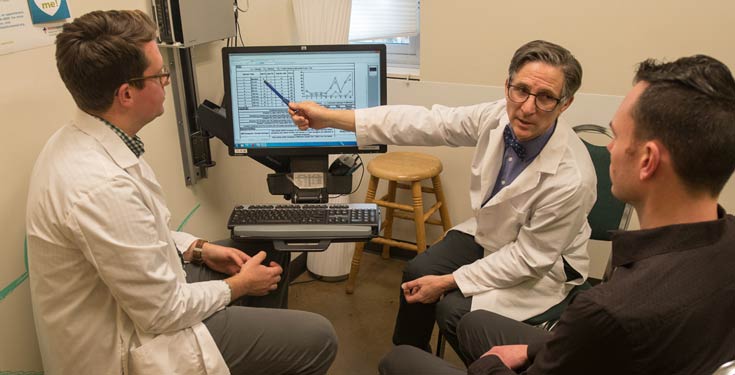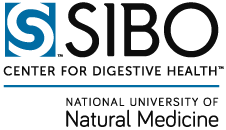 Watch Dr. Steven Sandberg-Lewis explain interpretation of various types of SIBO breath test results in this short video:
Watch Dr. Steven Sandberg-Lewis explain interpretation of various types of SIBO breath test results in this short video:
Currently there is no universal standard for interpreting breath test results. Our standard for reporting test results is based on the manufacturer’s guidelines and research-based evidence in the literature. However, these are only guidelines and the NUNM SIBO Center Lab strongly encourages providers to consider other determining factors in addition to test results when diagnosing and treating SIBO.
Interpretation Guidelines:
The results reported by the NUNM SIBO Lab are based on the manufacturer’s recommendations, which uses the difference between the peak value compared to the lowest preceding value in the first 120 minutes (+/- 5 min deviation). SIBO may be suspected for increases ≥ 20 PPM for H2, ≥ 12 PPM for CH4, and ≥ 15ppm for combined H2+CH4. (1)
High Baseline & Methane ≥ 3ppm:
Some reports suggest an elevated baseline value above expected values is positive for SIBO. (2-5) However, interpretation of elevated hydrogen remains unclear (6, 7) and may be due to other factors such as improper test preparation. (3, 5, 6, 8) A high baseline for methane and an early rise is a standard methane pattern (9). Gas levels that fall after an elevated baseline and continue to reduce or remain low during the first two hours, may indicate an improper preparation diet. (3, 5)
A recent paper reports high accuracy of using methane baseline levels between 4-5 ppm to diagnose “methane-positive” SIBO even at baseline (10), and there have been some reports of using methane values as low as 1-3ppm or higher as a methane positive in lactulose or glucose tests. (11-13) However, the most widely used criteria to indicate SIBO is suspected ranges between 10-12 ppm at any time during the test. (1, 7, 12)
False-positive results may be caused by not following the test preparation and collection guidelines (for example, smoking, sleeping or eating during the test or one hour before the test). Most false-negative tests can be avoided by testing for methane. However, there are other situations that may cause false-negative results, such as one or more invalid samples which may lead to a false negative result.
How does the analysis work?
The breath-tracker machine is manufactured by Quintron, and it works by checking the breath sample for an appropriate amount of carbon dioxide as well as the hydrogen and methane present. If the sample does not have enough carbon dioxide, it will consider it invalid and not give results for the other two gasses. If a test has an invalid sample, but is otherwise positive, the results are sent normally. If a test has an invalid sample, but is otherwise negative, the SIBO lab will send a notice to the provider that the results may be a false negative and recollection is warranted to obtain accurate results. Only in the situation of a possible false negative can the patient do a retest for the material cost only.
The results came back as a “possible false negative.” What does that mean?
Usually, this means that the air in the tube is not from the patient’s lungs, so it cannot give an accurate result. The tubes are vacuum sealed and when the rubber stopper is punctured, they will draw in the first air available, so it is important that the sample is truly air from the lungs. Please see the invalid samples explanation below for a more detailed explanation of how invalid samples occur and the ways to fix them.
Invalid Samples Explanation
At times, a report may come back with samples that are marked QNS (Quantity Not Sufficient). The Quintron BreathTracker analyzes the SIBO tubes and uses the Carbon Dioxide of the samples in order to give appropriate readings for the Hydrogen (H2) and Methane (CH4) levels present. If the CO2 is too low, the sample is invalid and no H2 or CH4 results are produced. The tubes are vacuum sealed and when the rubber stopper is punctured, they will draw in the first air available, so it is important that the sample is truly air from the lungs. If a test has a QNS sample, but is otherwise positive, the results are sent normally. If a test has a QNS sample, but is otherwise negative, the SIBO lab will send a notice to the provider that the results may be a false negative and recollection is warranted to obtain accurate results. Only in the situation of a possible false negative can the patient do a retest for the $75 material cost. These are the most common sampling errors and their corrections:
- Putting the tube on the needle before breathing into the collection device. This is the most common sampling error leading to QNS samples. Reason: Room air has contaminated the sample. Correct collection method: Make sure you are breathing out before you puncture the tube with the collection device needle. Once you put the tube on mid-exhalation, hold the tube in place for two seconds and then remove it before your breath is complete.
- Taking a very big inhalation before the sample. Reason: Room air has contaminated the sample. Correct collection method: Make sure to take a normal breath in, as you would in normal breathing.
- Putting the tube on the needle at the beginning of the exhalation instead of midexhalation. Reason: If you put the tube on early, the air in the tube will be air from your trachea, but we want to wait until mid-exhalation to capture the air from your lungs. Correct collection method: Put the tube on mid-exhalation, hold the tube in place for two seconds, and then remove it before your breath is complete.
- Puncturing the tube more than once. Reason: This may cause the sample to leak out of the tube before it can be analyzed. Correct collection method: Only puncture the tube once. If a tube is mistakenly punctured twice, please still submit the tube for analysis as the sample may still be valid
The patient had a “possible false negative” test with an invalid sample. How do they retest?
We will send results to the ordering provider, who must confer with the patient to determine whether they want to retest. If so, the patient needs to contact the SIBO Lab within 30 days of the original test results being sent to the doctor.
The results say that this patient is positive. What now?
The NUNM SIBO Lab is only able to run the test and send results to the physician. We cannot give any medical advice for treatment of SIBO or any other illness. Treatment for SIBO can be a variety of things, from antibiotics, to herbal supplements, to the elemental diet, all depending on what you and your patient choose as the best course of action.
The results say that this patient is negative. What now?
We are a reference lab, so we base our “normal” and “high” on what the manufacturer (Quintron) has stated. According to them, a test is considered positive when the Hydrogen increases by 20ppm, the Methane by 12ppm, or the combined by 15ppm. Only when the results show a change greater than these numbers will it show as positive on the final test report.
Some doctors not only look at the change, but at the raw number itself. So a Hydrogen level over 20ppm, a Methane over 12ppm, or a combination over 15ppm would be positive to them. See this NDNR article by Allison Siebecker and Steven Sandberg-Lewis for examples and explanations of this.
Some doctors also feel that a Methane level of over 3 (regardless of increase levels) indicates a positive as there is some sort of bacteria present. (The only way you have methane in your system is from bacteria fermenting food). So the doctors who see that as a positive will treat it, even though the test itself says “negative” on the results. Visit this site for more information about negative results.
While not common, the possibility of a flat-line test has been documented in literature about SIBO with indications that up to 5% of test takers can have flat-line results, either indicating a negative SIBO test, or the presence of Hydrogen Sulfide (which the lactulose breath test does not check for). See the links below for more information about H2S and flat-line SIBO tests:
References:
1. “Protocols and Interpretation Help: Hydrogen/Methane Breath Tests.” 2018, Rev A. QuinTron Instument Company. Handout.
2. Perman JA, Modler S, Barr RG, Rosenthal P. Fasting breath hydrogen concentration: Normal values and clinical application. Gastroenterology. 1984;87(6),1358-63.
3. Hamilton LH. Breath tests and gastroenterology. Milwaukie, WI. 1998.
4. Romagnuolo J, Schiller D, Bailey RJ. Using breath tests wisely in a gastroenterology practice: an evidence-based review of indications and pitfalls in interpretation. Am J Gastroenterol 2002; 97:1113–1126.
5. Siebecker A, Sandberg-Lewis S. The finer points of diagnosis, test interpretation, and treatment. Naturopathic Doctor News and Review, January 2014, 10:46. http://ndnr.com/gastrointestinal/sibo/
6. Kumar S, Misra A, Ghoshal UC. Patients with irritable bowel syndrome exhale more hydrogen than healthy subjects in fasting state. J Neurogastroenterol Motil. 2010;16,299-305.
7. Rezaie A, Buresi M, Lembo A, et al. Hydrogen and methane-based breath testing in gastrointestinal disorders: The north American consensus. Am J Gastroenterol. 2017;112(5),775-784.
8. Saad RJ and Chey WD. Breath testing for small intestinal bacterial overgrowth: Maximizing test accuracy. Clinical Gastroenterology and Hepatology. 2014; 12(12),1964-1972.
9. Pimentel M, Lin HC, Enayati P, et al. Methane, a gas produced by enteric bacteria, slows intestinal transit and augments small intestinal contractile activity. Am J Physiol Gastrointest Liver Physiol. 2006;290(6):G1089-95.
10. Gottlieb K, Le C, Wacher V, et al. Selection of a cut-off for high- and low-methane producers using a spot-methane breath test: Results from a large north American dataset of hydrogen, methane and carbon dioxide measurements in breath [published correction appears in Gastroenterol Rep (Oxf). 2018;6(3),242]. Gastroenterol Rep (Oxf). 2017;5(3),193–199. doi:10.1093/gastro/gow048.
11. Hwang L, Low K, Khoshini R, et al. Evaluating breath methane as a diagnostic test for constipation-predominant IBS. Dig Dis Sci. 2010;55,398-403.
12. Kunkel D, Basseri RJ, Makhani MD, Chong K, Chang C, and Pimentel, M. Methane on breath testing is associated with constipation: A systematic review and meta-analysis. Dig Dis Sci. 2011;56,1612-1618. doi:10.1007/s10620-011-1590-5.
13. Pimentel M, Chang C, Chua KS et al. Antibiotic treatment of constipation-predominant irritable bowel syndrome. Dig Dis Sci. 2014; 59:1278–1285. doi:10.1007/s10620-014-3157-8.

